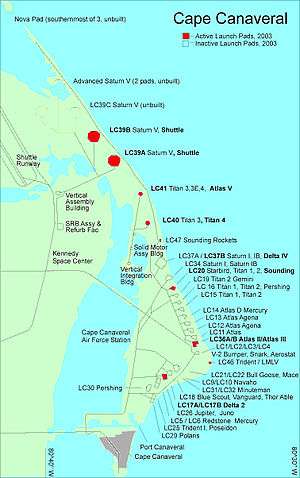List of Cape Canaveral and Merritt Island launch sites


Cape Canaveral and adjacent Merritt Island on Florida's Atlantic coast are home to two American spaceports, one civilian and one military, servicing several active launch sites.
John F. Kennedy Space Center
The civilian John F. Kennedy Space Center, operated by NASA, has one launch complex with two pads on Merritt Island. From 1968–1975, it was the site of 13 Saturn V launches, three manned Skylab flights and the Apollo-Soyuz Test Project; all Space Shuttle flights from 1981–2011, and 1 Ares 1-X flight in 2009.
| Site | Status | Uses |
|---|---|---|
| Launch Complex 39A | NASA has leased LC-39A to SpaceX; SpaceX is in pad redesign process[1][2] |
Prior: Saturn V, Space Shuttle Future: Falcon 9 full thrust, Falcon Heavy |
| Launch Complex 39B | Inactive | Prior: Saturn V, Saturn IB (Skylab and Apollo-Soyuz), Space Shuttle Future: Space Launch System |
Cape Canaveral Air Force Station
The military Cape Canaveral Air Force Station (CCAFS), operated by the 45th Space Wing of the U.S. Air Force, was the site of all pre-Apollo 8 manned launches, as well as many other early Department of Defense (DoD) and NASA launches. For the DoD, it plays a secondary role to Vandenberg AFB in California, but is the launch site for many NASA unmanned space probes, as those spacecraft are typically launched on Air Force launchers. Active launch vehicles are in bold.
Much of the support activity for CCAFS occurs at Patrick Air Force Base to the south, its reporting base.
Active sites
| Site | Status | Uses |
|---|---|---|
| Launch Complex 13 (Landing Zone 1) |
Active | Current: SpaceX Falcon 9 and Falcon Heavy first stage landing site[3] Formerly: Atlas, Atlas Agena |
| Space Launch Complex 37B | Active | Current: Delta IV Formerly: Saturn I, Saturn IB |
| Space Launch Complex 40 | Damaged | Current: Falcon 9 full thrust Formerly: Titan III, Titan IV |
| Space Launch Complex 41 | Active | Current: Atlas V Formerly: Titan III, Titan IV |
Inactive sites
Spaceport Florida
As of 2008, the U.S. Air Force committed to lease Cape Canaveral Air Force Station Space Launch Complex 36 to Space Florida for future use by the Athena III launch system.[5] It is not known if the plan was subsequently implemented. Blue Origin leased Complex 36 in 2015, with plans to launch its reusable orbital vehicle from there by 2020.[6]
| Site | Status | Uses |
|---|---|---|
| Space Launch Complex 36A | Pending Reactivation[6] | Atlas/Centaur,[5] Atlas II, Blue Origin orbital vehicle (future)[6] |
| Space Launch Complex 36B | Pending Reactivation[6] | Atlas, Atlas II, Atlas III, Blue Origin orbital vehicle (future)[6] |
| Space Launch Complex 46 | Pending Reactivation[7] | Athena, Trident II,[8] Minotaur IV (future) |
Other
| Site | Status | Uses |
|---|---|---|
| Atlantic Missile Range drop zone | Inactive | High Virgo, Bold Orion, Hound Dog, Skybolt |
| Grand Turk Auxiliary AFB, Grand Turk Island drop zone | Inactive | Arcas (All-Purpose Rocket for Collecting Atmospheric Soundings) |
| Mobile Launch Area | Inactive | Lark, Matador, Snark[9] |
| SLBM Launch Area | Inactive | Polaris, Poseidon, Trident |
| Shuttle Landing Facility | Active | Pegasus |
| Cape Canaveral AFS Skid Strip | Active | Navaho, Pegasus, Pegasus XL |
| Patrick AFB | Inactive | Matador |
References
- ↑ "SpaceX to bid for rights to historic NASA launch pad". Phys.org. 2013-12-13. Retrieved 2013-12-15.
- ↑ Boyle, Alan (2013-12-13). "SpaceX wins NASA's nod to take over historic Launch Pad 39A". NBC News. Retrieved 2013-12-18.
- ↑ Gruss, Mike. "SpaceX Leases Florida Launch Pad for Falcon Landings". Spacenews. Retrieved 13 February 2015.
- ↑ "Launch Complex 29". Air Force Space & Missile Museum. Retrieved 2011-12-15.
- 1 2 Craig Covault (Oct 27, 2008). "Boeing Joins Commercial Athena III Program". Retrieved 2010-12-23.
- 1 2 3 4 5 "Coming to the Space Coast". Blue Origin. 2015-09-15. Retrieved 2016-06-28.
- ↑ Messier, Doug (11 February 2014). "ATK to Upgrade Space Florida's Launch Complex 46". Parabolic Arc. Retrieved 24 December 2014.
- ↑ "Complex 46". robsv.com. Retrieved 7 May 2016.
- ↑ "HISTORIC AMERICAN ENGINEERING RECORD, CAPE CANAVERAL AIR FORCE STATION, LAUNCH COMPLEX 34 OPERATIONS SUPPORT BUILDING" (PDF). National Aeronautic and Space Administration. Retrieved 28 September 2016.